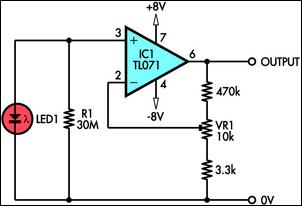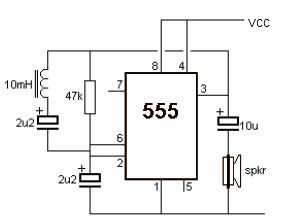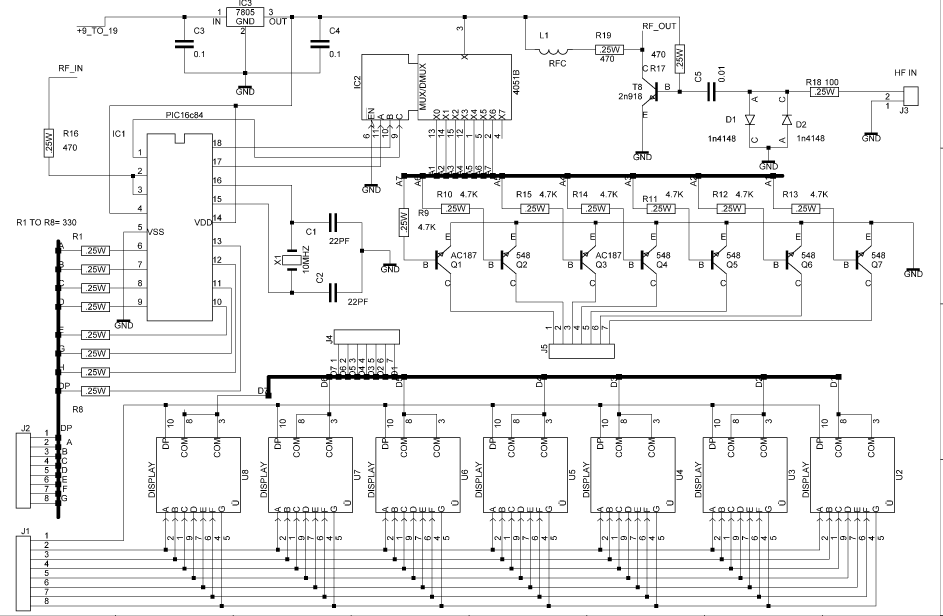
using led as a light sensor

This circuit demonstrates the use of a standard LED as a light sensor. It utilizes the photovoltaic voltage generated across the LED when exposed to light. LEDs are more cost-effective than photodiodes and feature an integrated filter, which is advantageous for applications requiring color discrimination. The photovoltage of a red LED, corresponding to its bandgap voltage, is generally around 2V. The source impedance of this voltage is approximately 800 MΩ in daylight, increasing to infinity in darkness. A TL071 JFET input operational amplifier is employed to amplify and buffer this high-impedance signal.
The circuit operates on the principle that when an LED is illuminated, it generates a small voltage due to the photovoltaic effect. This phenomenon occurs when photons strike the semiconductor material of the LED, causing electron-hole pairs to form and generating a measurable voltage. The generated voltage can be influenced by the intensity and wavelength of the incident light, making this configuration suitable for various light-sensing applications.
In the described circuit, the red LED serves as the light sensor, producing a voltage output that varies with light exposure. The TL071 operational amplifier, known for its high input impedance and low output impedance, is critical for ensuring that the signal from the LED is not adversely affected by loading effects. The operational amplifier is configured as a non-inverting amplifier, which allows for both amplification and buffering of the signal.
The circuit's design should include appropriate biasing and gain settings for the TL071 to optimize performance. A feedback resistor network can be implemented to set the gain, while ensuring that the input impedance remains sufficiently high to accommodate the LED's output without drawing significant current. Additionally, bypass capacitors may be added to the power supply lines of the op-amp to minimize noise and improve stability.
This configuration is particularly useful in applications where cost and space are constraints, such as in portable devices or low-power sensors. The ability to discriminate colors based on the LED's characteristics further enhances the versatility of this circuit in various optical sensing applications.This circuit shows how to use an ordinary LED as a light sensor. It makes use of the photovoltaic voltage developed across the LED when it is exposed to light. LEDs are cheaper than photodiodes and come with a built-in filter, which is useful when the application involves colour discrimination. The photo-voltage of a red LED (its bandgap voltage) is typically about 2V. The source impedance of this voltage is about 800M? in daylight, rising to infinity in darkness. A TL071 JFET input op amp is used to amplify and buffer this extremely high impedance signal.. 🔗 External reference
The circuit operates on the principle that when an LED is illuminated, it generates a small voltage due to the photovoltaic effect. This phenomenon occurs when photons strike the semiconductor material of the LED, causing electron-hole pairs to form and generating a measurable voltage. The generated voltage can be influenced by the intensity and wavelength of the incident light, making this configuration suitable for various light-sensing applications.
In the described circuit, the red LED serves as the light sensor, producing a voltage output that varies with light exposure. The TL071 operational amplifier, known for its high input impedance and low output impedance, is critical for ensuring that the signal from the LED is not adversely affected by loading effects. The operational amplifier is configured as a non-inverting amplifier, which allows for both amplification and buffering of the signal.
The circuit's design should include appropriate biasing and gain settings for the TL071 to optimize performance. A feedback resistor network can be implemented to set the gain, while ensuring that the input impedance remains sufficiently high to accommodate the LED's output without drawing significant current. Additionally, bypass capacitors may be added to the power supply lines of the op-amp to minimize noise and improve stability.
This configuration is particularly useful in applications where cost and space are constraints, such as in portable devices or low-power sensors. The ability to discriminate colors based on the LED's characteristics further enhances the versatility of this circuit in various optical sensing applications.This circuit shows how to use an ordinary LED as a light sensor. It makes use of the photovoltaic voltage developed across the LED when it is exposed to light. LEDs are cheaper than photodiodes and come with a built-in filter, which is useful when the application involves colour discrimination. The photo-voltage of a red LED (its bandgap voltage) is typically about 2V. The source impedance of this voltage is about 800M? in daylight, rising to infinity in darkness. A TL071 JFET input op amp is used to amplify and buffer this extremely high impedance signal.. 🔗 External reference





